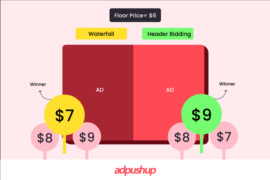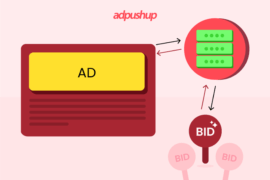Header bidding vs RTB (real-time bidding) has been one of the most common questions asked by the publishers. There’s a lot of confusion around header bidding vs RTB and it is easy to see why as both these terms get tossed around a lot in ad tech industry. In fact, there are plenty of blogs out there on the internet, titled “header bidding vs RTB”.
But what if we tell you both header bidding and real-time bidding aren’t meant to be compared against each other? In reality, header bidding operates within the framework of real-time bidding.
In other words, header bidding uses real-time bidding to find the highest-paying advertisers. Header bidding is actually an improvement on top of Real Time Bidding (RTB).
Since header bidding falls under real-time bidding, let’s understand exactly what it is before we get into header bidding vs rtb.
What is Real-Time Bidding? (Real Time Bidding Explained)
Real time bidding is a process, which allows for buying and selling ad impressions in real-time through an online auction. It’s an impression-level auction happening in real time (in the time between the user requesting a web page and the page load completion). This automated, instantaneous ad buying/selling is synonymous with programmatic advertising.
What is an Example of Real-Time Bidding?
Think of it like a fast-paced game of musical chairs.
Imagine a room full of chairs (ad placements) and people (advertisers) circling around them. As the music starts (user requests a web page), everyone rushes to grab a chair (place a bid) before the music stops (page load completes).
The chairs are quickly filled by the highest bidders, and those who didn’t secure a chair miss out on displaying their ad to the user. It’s all about reacting quickly and strategically to secure the best placement for your ad in real-time.
Now that you know what is RTB, let’s have a look how RTB advertising work.
How Does Real Time Bidding Work?
When you visit a webpage, the details about the ad space (like size and location), the page itself, and your browsing history are sent to the website’s ad server. If the ad space hasn’t already been sold directly, it goes to an ad exchange where multiple advertisers can bid on it.
Here’s how it works:
- Advertisers place their bids to show you an ad.
- Auction Types:
- Second-Price Auction: The highest bid wins, but the winner pays only 1 cent more than the second highest bid. This ensures the winner pays a fair price close to the actual value and avoids overpaying.
- First-Price Auction: The highest bid wins and the winner pays the exact amount they bid. This simplifies the auction process and provides more transparency.
- The highest bid wins according to the auction type being used.
Finally, the winning ad is displayed on the webpage.
The entire process takes milliseconds.
It was a huge improvement over previous transaction models where inventory was purchased in bulk with no regards to targeting. We have published a pretty detailed guide on RTB, to explain how it took over traditional forms of display ad transactions.
Why Was Real-Time Bidding Popular?
RTB allows for Addressable Advertising; the ability to serve ads to consumers directly based on their demographic, psychographic, or behavioural attributes.
— IAB, OpenRTB Project
Publishers could set floor prices to maintain control over impression values and use Deal IDs to create special ad packages. By this time, The openRTB landscape comprised of different RTB types:
- Private auction flags (PMPs)
- Direct deals (programmatic direct)
- “First look” – Priority bidding for certain advertisers, often with additional publisher data.
Here’s how RTB is typically positioned in a publisher’s ad stack:
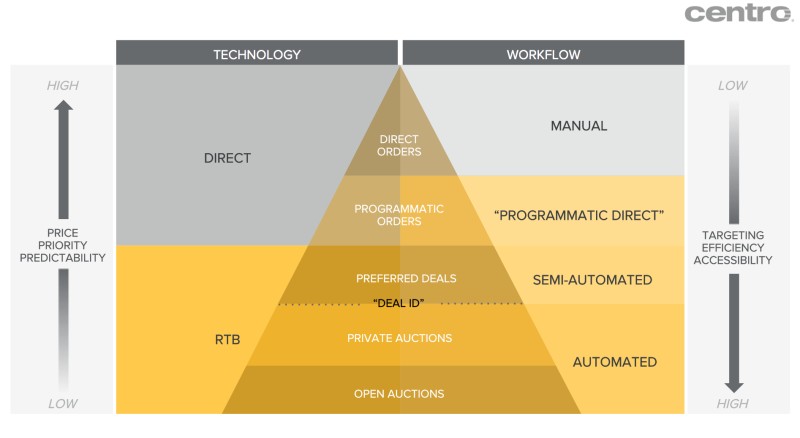
RTB is like online shopping… at once a mere convenience and also a game changer. Did we shop before the internet? Yes. And yet now we have more options, shop more efficiently, can personalize our experiences, and yes – often find better prices. As a result, we shop more and the total commerce pie has expanded.
— Josh MacFarland, CEO, TellApart (Source)
Why Was Real-Time Bidding Used?
Within the inventory allotted to RTB transactions works the waterfall: If an exchange fails to meet the required floor price before the timeout, the impression moved on to the next demand source and so on until it’s either cleared or returned to ad server unsold.
In a normal ad server waterfall setup, direct buys go first. Then, publishers allocate ad inventory to one or more exchanges, using estimates and averages of what each exchange can bring in – not by gauging demand in real time. As the dominant publisher ad server, Google’s DoubleClick for Publishers is often driving the bus throughout this process.
— Sarah Sluis, AdExchanger (Source)
How does Google’s DFP ‘drive the bus’?
By putting Google AdX in a privileged position through “dynamic allocationw” and “enhanced dynamic allocation”, which lets AdX surpass its position in the waterfall and bid first over every other demand source.
Dynamic allocation screws the other exchanges because it allows AdX to cherry-pick inventory.
— Anonymous Publisher, AdExchanger
Here’s where header bidding levels the playing field, and its rising popularity has Google attempting to compete with solutions like exchange bidding in Dynamic Allocation (within DFP). The header bidding pioneer, AppNexus, for its part, turned down the offer to take part in exchange bidding.
You can also take a look at this video to understand the difference between Header Bidding and the Waterfall method:
What is Header Bidding?
AppNexus was already working on a system that could replace the waterfall. In 2009, they released Prebid.js and open-sourced it.
By now, you probably know header bidding flattened the waterfall, both figuratively and literally. It sends out calls to multiple integrated SSPs simultaneously, instead of sequentially jumping from one exchange to the next.
Here’s Ben Kneen of AdOpsInsider, explaining the USP that makes header bidding so effective:
The key thing with header bidding is that it allows the publisher to know if there is demand for any given impression in the exchange before they make their ad serving decision. The user has to call the SSP before the ad server so the SSP can read the user’s cookie and value the impression. By doing this, the publisher can work with many different SSPs and not just a single one. To work with multiple SSP platforms, there has to be a mechanism to have them all compete at the same level, rather than silo-ing them in a waterfall.
Why Publishers Prefer Header Bidding?
Header Bidding leaves the traditional RTB waterfalls in the dust, where direct deals were prioritized over everything else because the publisher had no wish to sell premium inventory for pennies at open auctions.
Additionally, it forces competition across direct-sold and programmatic demand sources, increasing yield even further.
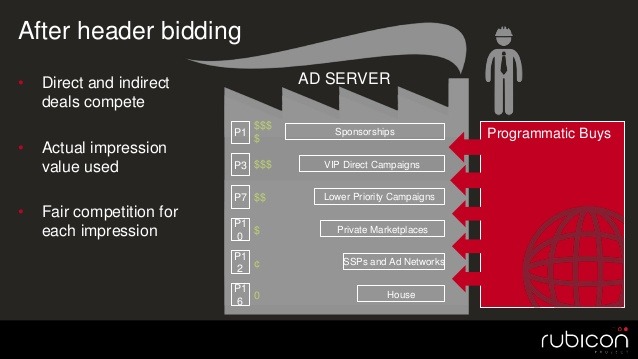
Thanks to header bidding, the traditional stack is inverted; it now looks more like this:
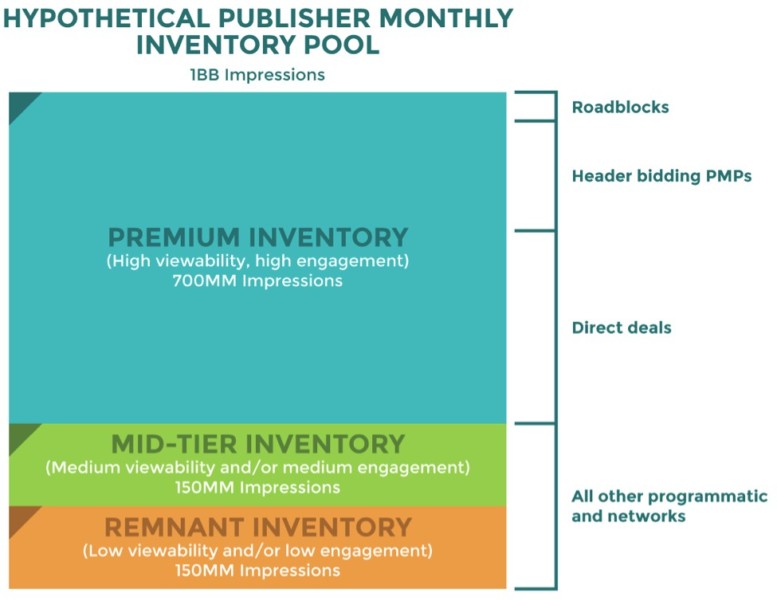
Header Bidding vs Real-Time Bidding: What’s The Difference?
RTB is automated, real-time impression-level bidding, enriched with user data. It is but a method of programmatic advertising which itself can take different forms (private or open), depending on the method of execution.
Header Bidding is a programmatic technique where a user (remember, header bidding is still done client-side by most publishers and the browser makes a lot of calls) sends the impression key to multiple ad exchanges simultaneously, retrieves the bid values, and then calls the ad server to display the winning creative (usually Google’s DoubleClick for Publishers).
What’s the difference?
In a traditional RTB setup, publishers sold away their inventory between direct deals and programmatic auctions (programmatic RTB), which possibly obscured the real value of premium impressions.
Header bidding breaks this wall and lets buyers compete for direct-sold inventory too, which can give sellers very real uplifts in revenue.
You may also like to know – Header Bidding vs Ad Mediation
Why Choose AdPushup Header Bidding Solution?
Merely deploying header bidding in your ad stack isn’t enough. Consistently optimizing it with technical improvements is the need of the hour. This is what AdPushup’s header bidding solution does. Through our multiple optimization features using data science and machine learning, we help publishers maximize their yield.
With our header bidding solution, you get:
- Automatic demand partner selection according to optimum requirements
- Smart timeout management
- Freedom to bring your own demand
- Bid monitoring and discrepancy resolution
Read more about our product capability: Header Bidding
Frequently Asked Questions
Header bidding allows publishers to simultaneously auction their ad inventory to multiple demand sources, including ad exchanges and SSPs, enabling them to maximize their revenue by securing the highest possible bids for their available ad space.
In contrast, real-time bidding (RTB) involves automated, real-time auctions for ad impressions but may not consider all demand sources simultaneously. This can result in potentially lower yields for publishers as compared to the more comprehensive and revenue-optimized approach of header bidding.
Yes, header bidding can be advantageous for publishers as it often leads to increased ad revenue and access to a wider range of advertisers. However, its effectiveness depends on proper implementation and optimization.
Header bidding and waterfall auctions differ in their auction processes. In header bidding, ad requests are sent simultaneously to multiple demand partners, while in the programmatic waterfall model, known as daisy-chaining, the bidding occurs sequentially, moving from one ad network to the next until all impressions are sold.
Programmatic advertising utilizes real time bidding. It allows advertisers to buy publishers’ ad inventory as it becomes vacant. This process allows for time-efficient ad buying/selling along with competitive pricing.

Deepak has a keen eye for detail and a deep understanding of the ad tech landscape. Whether it’s through in-depth articles, thought-provoking insights, or compelling storytelling, he’s dedicated to helping people navigate the complex world of ad tech with the simplicity of his words.



